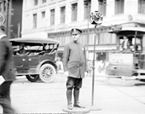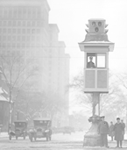
The Automobile Shapes The City
Traffic Control
Concerns over congestion led not only to massive highway construction, but also to the development of traffic control, both human and mechanical. Traffic signs and lights became an indelible part of the automobile infrastructure of cities—along with the presence of traffic police—and were graphic reminders of the need to effectively separate pedestrians from vehicles (and vehicles from vehicles). Even with various systems of traffic control in place in the early twentieth century, street and highway safety was chronically threatened. By the 1920s, accidents were frequent and many people were killed or injured every year on the roads and highways. In 1924, there were 23,600 deaths due to auto accidents, 700,000 injuries, and more than $1 billion in property damage. Between 1960 and 1972 alone motor-vehicle fatalities increased from 38,137 to 55,278. In 1989, motor-vehicle accidents ranked fifth among all causes of death in the United States. While automobile safety improved with the introduction of seat belts and airbags, traffic calming devices like speed bumps, and reduced speeds on certain roads and highways, the National Safety Council estimated that by the mid-1990s traffic fatalities cost $176.5 billion annually to the nation, with the cost of dealing with damages and injuries in nonfatal accidents raising the sum even higher.
At the turn of the twentieth century there were few rules for driving in American cities. The first law regulating the speed of automobiles was passed in Connecticut in 1901—12 miles per hour overall and 8 miles per hour in cities. When motor vehicles began to merge with existing traffic and shared the roads with pedestrians, horses, bicyclists, and streetcars there was little distinction between local and through traffic or the speed of the respective individuals or vehicles. Traffic controls of some type began to appear after the introduction of Ford’s mass-produced Model T and the incessant growth of the automobile population in cities. As historian Clay McShane noted, traffic lights, signs, and painted pavements not only commanded a new physical presence in cities, but “impose[d] a strong social control over the most fundamental of human behaviors, whether to move or to be still.”
Most immediately, traffic controls focused on the behaviors of motorists, pedestrians, and the police. Traffic control innovation occurred in the United States due to the rising traffic problem. Sending several police to busy corners proved too costly and too labor intensive, so early efforts at traffic control utilized railroad practices in the form of semaphore signals and midintersection towers manned by police. Neither worked very effectively. The first permanent installation of a red and green traffic control light—again based on railroad practices—occurred in Cleveland in 1914; in 1917 traffic lights in Detroit added a yellow caution light. The first red stop sign—or “boulevard stop”—was used in Detroit in 1914 and worked better than right-of-way ordinances passed by some cities. Adapting to the new signs proved difficult for drivers used to having their own way on the road, and some drivers resisted their introduction or simply disobeyed them. From these beginnings came a wide range of technologies—such as electronic coordinated signal networks for whole cities—that influenced driving behavior, street use, traffic patterns, and the form of the surface transportation system itself. As long as motorized vehicles and other forms of transportation were an integral part of city life, they posed risks as well as benefits.
<<Previous Section - Next Section>>
Introduction
The “Footprint” of the Automobile on the American City
From “Walking Cities” to “Automobile Cities"
Traffic Control
Filling Stations and Other Services
Expressways, Freeways, and Superhighways
Complete Text Printable View
About the Project | Credits | Contact Us | Student & Teacher Resources | Site Map
©2004-2010 Automobile in American Life and Society

